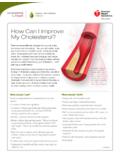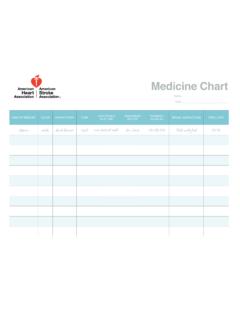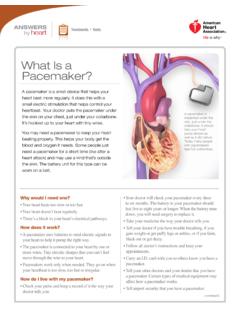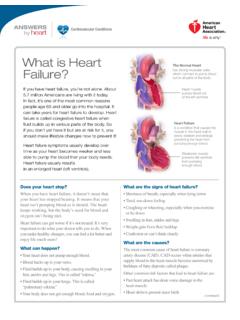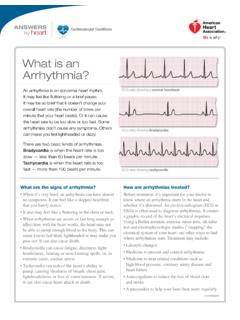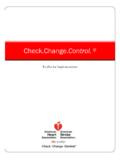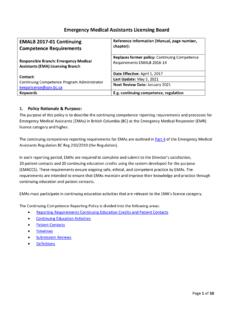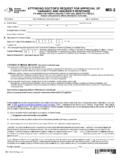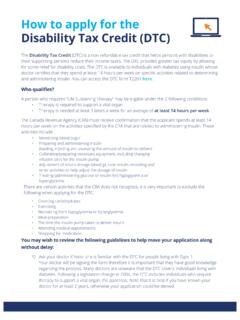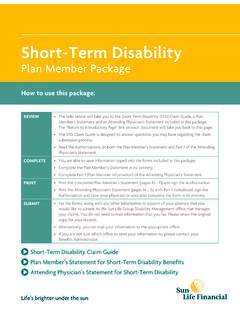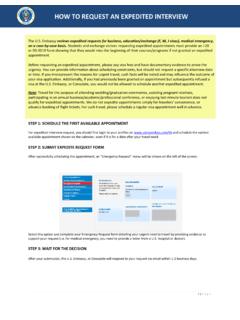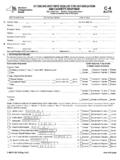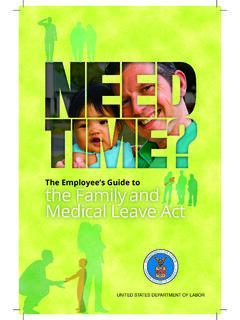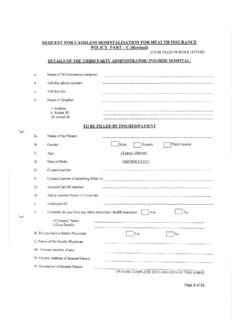Transcription of PEARLSScriptedDebriefing’Tool ’–’QuickstartGuide
1 PEARLS Scripted Debriefing tool Quickstart Guide Walter Eppich, MD, MEd, Adam Cheng, MD PEARLS Debriefing Framework REACTION. How did that feel? . DESCRIPTION. Can someone summarize what the case was about from a medical point of view? What were the main issues you had to deal with? . ANALYSIS. Pick one of the three methods below Learner Self-Assessment ( Plus-Delta) Directive feedback and teaching Focused Facilitation ( Advocacy- What aspects of the case do you think you I noticed you [insert performance gap here]. Inquiry). managed well? Next time, you may want to [close Elicit underlying rationale for actions: see What aspects of the case would want to gap] because [provide rationale] page 2 for approach change? . Are there any outstanding issues we haven't discussed yet before we start to close?
2 APPLICATION/SUMMARIZING. Learner Driven: I like to close the debriefing by having each you state one two take-aways that will help you in the future . PEARLS Scripted Debriefing tool Quickstart Guide Walter Eppich, MD, MEd, Adam Cheng, MD Advocacy-inquiry: pairing your point of view with a question to get trainees' perspective ADVOCACY - INQUIRY. Observation about a Express your point of view about the observed Ask about the perspective performance gap performance gap Appreciation I liked that . STEP 1: Appreciation or concern How do you see it? EXPLORE I was thinking I wonder what your thoughts were at the I noticed that . PERFORMANCE time? I heard you say . GAPS Concern What was going through your mind? I felt uncomfortable because.
3 I was worried/concerned . Clarify understanding of the Explore the rationale and close the performance Help learners generalize trainee's rationale for action gap STEP 2: UNDERSTAND. What strategies do you see going forward RATIONALE AND So what I'm hearing is that [insrt Teach to close performance gap when learning that would he helpful here? CLOSE performance gap] was related to need is clear How will this impact your performance PERFORMANCE [insert frame here] . next time? GAPS. Page 1 of 1. Postevent Debriefing Hot Core Elements (marked with *) Must be completed Subject ID Automatically Populated _____. How many hours after conclusion of event?* _____. Debrief Faciliator * RN. MD. PA. NP. Other (Lead facilitator discipline). Number in attendance: Nurses * _____.
4 Number in attendance: Physicians* _____. Number in attendance: NP and/or PA * _____. Number in attendance: Administrators * _____. *. Number in attendance: RT _____. Number in attendance: Students (nursing, medical, _____. etc.) *. Number in attendance: Other _____. (specify (#); specify (#)..). Duration of Debriefing * _____. (HH:MM (25 minutes = 00:25)). What Went Well? *. [Free Text]. What could have been improved upon in this patient's care? *. [Free Text]. Were there any delays in therapy? If so, provide a description of the delay. *. [Free Text]. How could this event have been predicted or prevented? *. [Free Text]. 01/06/2016 10:57am PEDIATRIC/NEONATAL CODE BLUE and RAPID RESPONSE 5 minute TEAM DEBRIEFING GUIDE. Goal: Debrief completed after all emergency responses.
5 Also debrief situations that 1) are outside the norm or offer an opportunity to identify system improvements. Any staff member may call for a debriefing. Hospitalist leads on acute care units; PICU/CV Attending leads in ICU's Date/time: _____ Patient name and MRN _____. Code Blue: Neonatal Pediatric Adult OR Rapid Response Call ECMO Call VAD call Pediatric Stroke call . Thinking about team performance in this emergency event: Identify what went easily (check all that apply): Communications were closed-loop, clear and heard; reports were in SBAR format Everyone knew what the emergency was (shared mental model). Team Leader was identified; leadership was clear; TL did not perform a task R-series ETCO2 and CPR feedback used to determine compression effectiveness and Return of Spontaneous Circulation (ROSC) by CPR Monitor Comments: _____.
6 _____. _____. Identify what was challenging? Communication issues Members on the team were not aware of what was going on (No Situational Awareness). There was no clear leadership (ONE Clear team Leader). No Crowd Control provided by Event manager and/or Charge Nurse Deviations from PALS /ACLS/ NRP algorithms (Explain). Compressor was not replaced every 2 minutes, No CPR Monitor Role Delay in obtaining access (Explain). Barriers that made it challenging (Explain what team thinks can be done to decrease barriers? Comments: _____. _____. _____. Thinking about this pediatric/neonatal emergency, identify system issues that need improvement (Check all that apply). Operator or Pager Issues Equipment issues Medications issues Crowd Control Issues Delays in transporting the patient (within the hospital).)
7 Push back to make the RRT call If RRT could have been called earlier . Comments: _____. _____. Code Roles in an emergency Event Manager assigned code roles; Ensured key members have armbands on upper arms; Assisted with Crowd Control;. Collected armbands to be returned to Defibrillator paddles; brought immediate together to conduct this hot debrief Primary RN stayed at bedside, performed ABC's; available for communication Recorder documented and prompted TL on algorithm CPR Monitor placed pads, prompted TL on 2 checks, Zoll CPR feedback; ETCO2; rotated compressors Team Leader checked and signed Code Record and participated in debrief Pharmacist announced arrival; given a table to work; established who was TL; provided the weight and algorithm being followed and offered Broselow Tape if no weight available Hospitalist at code cart and manage defibrillator; applying pads immediately; notifying TL when shock required Briefly describe: _____.
8 _____. CONFIDENTIAL: This is a quality improvement form that is confidential and protected under CA Civil Code 1157. Not for distribution. DO NOT SCAN INTO. MEDICAL RECORD. Please enclose this form with Code Record in an envelope and address to Code Committee Mail Code 5893 LK 4-1-14. PICU RESUSCITATION FORM. Attending ICU MD Present: PtName( ) Date( ) DY-Fully DY-Partially ON. MRN( }09C 09N 09T 011c Code Time:! I AM/PM RN:Pt Staffing Ratio: 01:1. 01:2. Code End Time: I I AM/ PM. How many people CodeOutcome: OAlive 0 Dead 0 ECMO in room (maximum): Do-5. 06-10. 011-15. Parental Request to Cease Resuscitation? DV ON 0>15. 0 Asystole 0 PEA SHOCKABLE RHYTHM? ON DV. Dvr DvF Time shockable rhythm detected:! IAM/PM. ::1: :c Dsinus Tach 0 JET Type of electricity: D Defibrillation D Cardioversion :c c,:: 0 Sinus Brady 0 NSR.)
9 Time of first shock: I jAM/ PM. Multiple shocks: DY ON. DA fib/flutter D svr Oother l!). TOOLS USED DURING CODE. INTUBATION? Dy ON D Already Intubated 0 Bag/ mask Meds given: r I. ooral airway Complications: 0 Multiple DL 0 Airway bleeding 0 Bag/ETI. D. Pneumothorax s D. >20% drop in 02 saturation 0 UuantETC02. c,:: <( D. Intubated by anesthesia . Appropriate PPV rate: ON DY D. Inconsistent 0 Fluid bolus COMPRESSIONS? Dy ON. 0. DElectrolyte bolus Duration: I Jmin . Ocardiac med bolus Good quality: DY D N D Inconsistent u c,:: Unnecessary pauses: DY ON. Vase access w/i 2 min? D Y ON. Privileged information for Debriefing performed: i:: 0 RN busy O No interest in debriefing ov Quality Improvement. Not to 0 MD busy D Resuscitation w/o problem - 0.
10 Be placed in patient charts. ON. 0 . C: "'. '!:: fl! Updated OOther DO NOT SCAN OR PUT INTO PATIENT CHART PEER REVIEW QI DEBRIEFING FORM. Post-Resuscitative Care Review This information is privileged and confidential - Peer Review Work Product 6/7/20156/7/2015. Advice for Team Debriefing: 1. Try to find a quiet, isolated place. Anyone present during the event may lead the debriefing. Debriefing leader should start by thanking team members for being present. 2. State: "The purpose of debriefing is to improve the quality of medical care by CHOP providers; it is not a blaming session. Everyone's participation is welcome and encouraged.". 3. State: "We will briefly review the patient's summary and then we can discuss what went well and what could have gone better.
